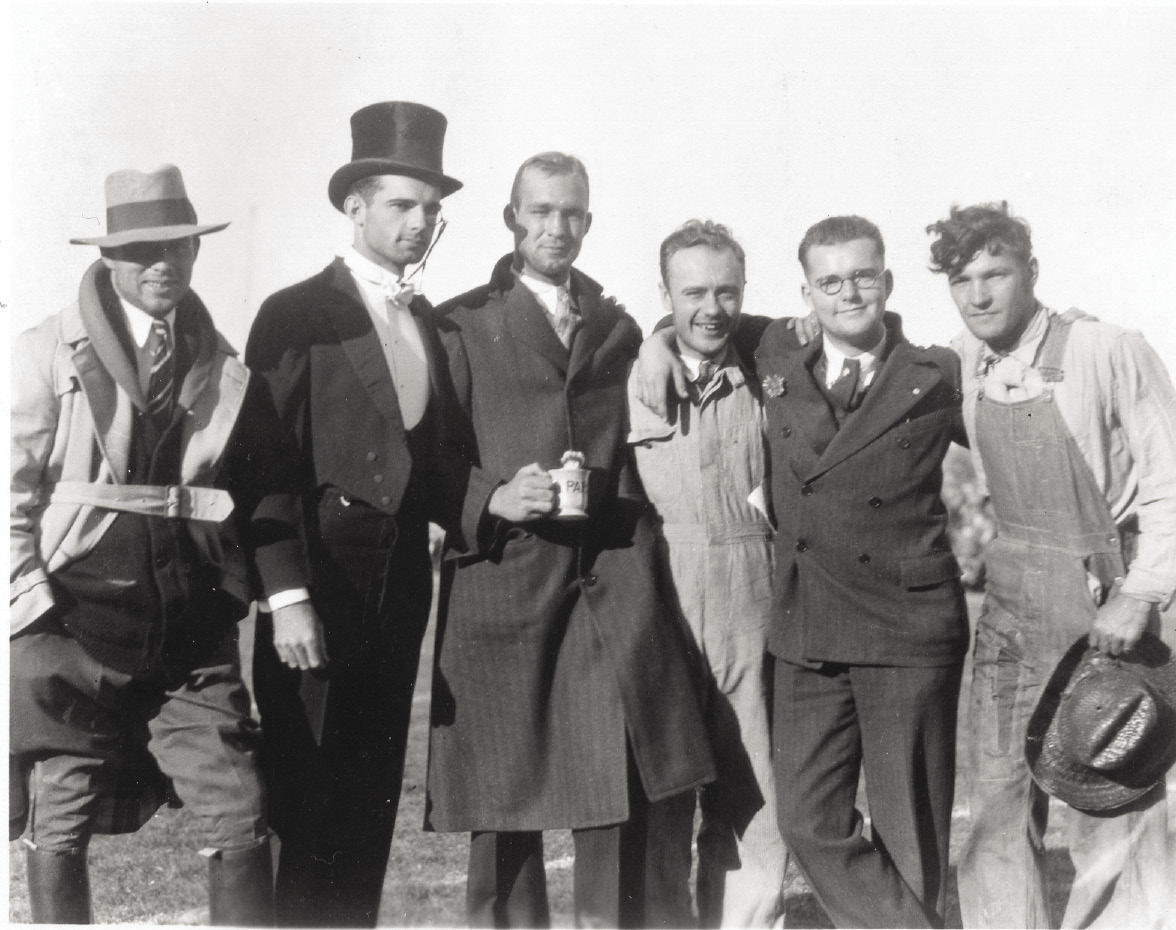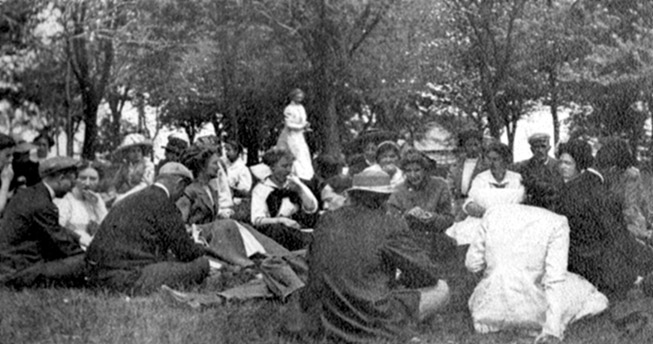
The year 2013 is the 100th anniversary of the founding of the alumni association. Looking forward to this milestone, The Shocker has shared a time line of association history in each print issue for the past several years. Now, we're jumping back to the association's beginning - to the year 1913.
The year 1913, like all years, tallies its own unique list of goals met and milstones passed. It has its own look and feel. Its own soundtrack. Globally in 1913, the United States churned out about 40 percent of the world’s industrial production, exceeding Britain, France and Germany combined. A rebuilt Grand Central Terminal in New York City reopened as the largest train station in the world. American suffragettes began concentrating efforts on the passage of a constitutional amendment, and women won the right to vote in presidential elections in the states of Illinois and Alaska.
At the beginning of 1913, Theodore Roosevelt was the president of the United States, and on March 4, Woodrow Wilson, the former governor of New Jersey, was inaugurated as the 28th U.S. president. The Philadelphia Athletics defeated the New York Giants to win the 1913 World Series by four games to one. And the top song of the year was When Irish Eyes are Smiling by Chauncey Olcott.
Atop Fairmount Hill, just north of Wichita’s burgeoning downtown, the institution of higher education that had been established in 1895 as Fairmount College under its first president Nathan Morrison (1895-1907) with 30 students was, in 1913, growing by leaps and bounds.
Thus, so was Fairmount’s alumni body, whose members coalesced around the leadership of a dapper young Fairmount College graduate to organize and set up the college’s first official alumni association. That leader was Harry Shuler ’13/30, who studied mathematics and literature at Fairmount and earned a bachelor’s degree in economics in 1913, the same year he began his two-year term as president of the newly established alumni association.
As an undergraduate, Shuler, who later earned a master’s degree in education from the University of Wichita, served on the staff of the student newspaper, The Sunflower. Within the alarmingly titled article “Epidemic Proves Fatal,” published in the paper’s Sept. 20, 1915 issue, Shuler’s marriage is announced: “Another victim of the matrimonial epidemic is Harry Shuler, also of the class of ’13. He was married to Miss Edith May Mosher of Lawrence, Michigan, a few days ago.”
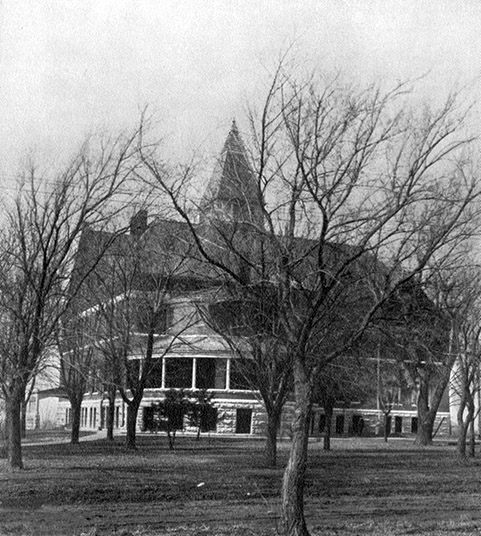
organized, Fairmount Hall was still the signature building
on campus. A popular campus locale for romantically
inclined students was the Spoonholder, a wooden bench
encircling an elm tree growing in front of the hall.
The college that Shuler covered as a Sunflower reporter was presided over by Fairmount’s second president Henry Thayer (1907-1914). Shuler and his fellow Fairmount students were heirs to a unique college history, one that featured wheatshockers and sunflowers. Soon after Fairmount College was founded, students voted to adopt black and sunflower yellow as the school colors. They also launched and named the student newspaper.
In 1904, after being asked to help promote a game against the Chilocco “Indians,” football manager Roy Kirk coined the name “Wheatshockers.” The name came to him because so many of the football players and other college students of the time worked in the fields shocking wheat. Another college tradition, the yearbook Parnassus, was begun in 1902.
In 1914, the Parnassus included a page titled “The Alumni.” In the style of the time, this is what was written:
The element of prosperity of Fairmount is represented by the Alumni. The Alumni fit in between the progressive college student and the conservative college professor. This group of individuals is putting their college training into practical use. These men and women, having homes of their own, or, if not, have given up all hopes of ever having one, are people who governed the school a few years past, and who will govern the state within the next few years. … (We) are of the opinion that the Alumni is a good, loyal bunch of Fairmounters. We must remember it takes years of time for any group of people to become well established. The Alumni association of Fairmount is a young organization. …
(We) appreciate the things the Alumni have done for Fairmount, and during the past year, especially. Never failing to appear at the games and join in the rooting for F. C., and victory, they add materialy (sic) to the spirit of Fairmount. By means of buying athletic sweaters for the football men, and donating money for various athletic goods, they aid the material development of the college.
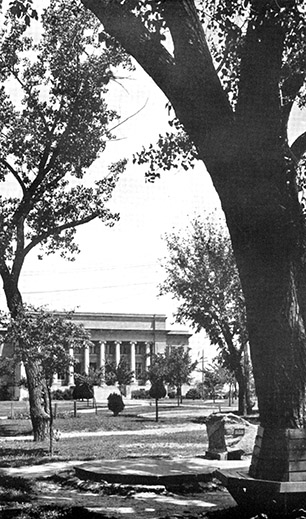
called the Carnegie Library before being renamed
in honor of the college's first president Nathan
Morrison. With its stately Ionic columns, the library
vied with Fairmount Hall as the most dominant
building on campus. The Spoonholder bench can
be seen in the right foreground of the photo.
Although the Alumni has never produced a President of the United States nor a Governor of Kansas, it is only a question of time, until she will produce a favored son. There are, at the present time, Fairmount Alumni who are successful in nearly all walks of life; there are Fairmount graduates in nearly every state in the union, and in nearly every nation in the world. There is plausible reason to conjecture that the man who is destined to be the saviour of his state or nation, has already passed through the doors of the college.
Walter Rollins (1914-21) and John Finlayson (1922-27) followed Morrison and Thayer as the next two presidents to serve Fairmount College. Fairmount’s graduates — as would those of the University of Wichita (1926-1963) and Wichita State University (1964-present) — chose a variety of careers, becoming teachers, businessmen, engineers, scientists, doctors, lawyers, farmers, journalists, artists, ministers, musicians and politicians — although it would be decades yet before the university would produce a governor of Kansas, as conjectured in the 1914 Parnassus: Mark Parkinson ’80 served as the state’s 45th governor from April 28, 2009 to January 10, 2011.
In 1916 — at 8 p.m. on Dec. 26, to be precise — graduates of Fairmount College began arriving at the home of President and Mrs. Rollins for the Third Annual Holiday Alumni Reception. “Between 65 and 70 old Fairmount students were present, and all the classes were represented with the exception of 1909,” reports the Jan. 8, 1917 issue of The Sunflower. The article continues, “After all had arrived the visitors were divided into the classes to which they belonged. Each class was then directed to select one from their number to tell the funniest stories (about what) happened while they were in Fairmount. Some of the stories told between giggles by staid preachers, lawyers, farmers, wives and husbands — some of whom had children in high school — were about the cap and gown scraps and how they soaped the street car tracks on Hallowe’en.”
Amidst the laughter, a serious track was also taken during the alumni reception at the president’s home. “Professor Binnewiess,” reports the Sunflower, “said to the alumni that it was to their interest to push the college forward, for when Fairmount becomes a stronger school, then their degrees will stand for that much more. And the professor was exactly right in what he said. The alumni realize the situation and are getting behind the college in a very material way, to the amount of $2,000 per year toward running expenses.”
Monies were raised through fundraising efforts for what was named simply the “Alumni Fund.” The Sunflower periodically ran Alumni Fund updates, such as this one from the May 2, 1916 paper:
Alumni Fund April 29, 1916
The class of 1901 is the banner class, every member having contributed to this fund.
Class Amount
1492 (Sic) ………………………$34.50
1899 …………………………………22.00
1901 …………………………………40.00
1903 …………………………………25.00
1907………………………………… 63.50
1909 ………………………………… 35.00
1913 ………………………………… 20.00
1915 …………………………………10.50
Total ………………………… $216.00
1902 …………………………………50.00
1904 …………………………………10.00
1906 ………………………………… 5.00
1908 ……………………………………25.00
1910…………………………………… 28.00
1912 …………………………………… 70.00
1914 ………………………………… 10.00
Total …………………………… $198.00
Total of Totals …………… $448.50
On January 11, 1916, Fairmount’s student paper runs this notice in a news column on Page 2:
That the alumni are coming into their own is shown by the fact that they have gotten sufficiently strong to publish a magazine all their own, and which has to deal with problems and news which concern them primarily. The first issue of the new periodical was published just before Christmas and is very creditable. Miss Elinor Beebe ’14, who edited The Sunflower two years ago, is at the head of the editorial staff, and Arthur Solter ’07 is the business manager. The Sunflower wishes The Fairmount Alumnus all the success possible and a wide influence in behalf of Fairmount.
In 1921, the last year of President Rollins’ tenure at Fairmount College, alumni association officers and members came together to make plans for their coming year’s work. A report penned by Mable (Bruce) Henrion ’17 provides a look into the group’s planning session. “Last year,” the report relates, “the association voted to start an endowment fund for the college. Everyone was enthusiastic at that time, but up to date very little has been done toward this. A new attempt must be made and this carried through. This is one thing each member can do for the college which has done so much for him.”
Henrion’s report goes on to announce a new association undertaking for the 1922 commencement ceremonies, the initiation of the “five year reunion custom” that was being employed with success at many other colleges and universities: “As in the past the Alumni will take a great part in the commencement exercises, which is the only time a large number can get together. This year … special arrangements and reservations will be made for the classes of ’02, ’07, ’12, ’17.”
Mable Henrion, who was the wife of Paul Henrion ’18 (president of the alumni association from 1938 to 1940), also promoted in her 1921 report an association event that had become an annual tradition. “As usual, the evening service on the Sunday preceding the commencement exercises will be in the hands of the Alumni,” she wrote. “Those who attended the service last year will realize what an opportunity and pleasure this is for the probability of seeing old friends who may not get out to the other exercises. It is a fine thing to look forward to in these exercises.”
The first woman to serve as alumni association president was Marie Graham ’15/16, who held the organization’s top office from 1924 to 1926. As a Fairmount student, Graham was described in the 1915 Parnassus as “a girl of numerous talents and a very pleasant disposition.” She served as president of Sorosis and was active in YWCA and as a member of the student council. She also played in Fairmount’s band and was a first soprano in the glee club, whose members were sure to have taken note of the two top songs of 1926: Bye Bye, Blackbird by Gene Austin and Al Jolson’s When the Red, Red Robin Comes Bob-Bob-Bobbin’ Along. Since Graham’s service as president, a dozen other strong-minded women have led the alumni association, including her immediate successor Ruth (Miller) Ross ’20, who earned a bachelor’s degree in French and who held the presidency from 1926 to 1927 — her tenure coinciding with the inaugural year of the University of Wichita.
From Fairmount to WU
President John Finlayson holds the distinction of being the last president of Fairmount College and the first president of the University of Wichita. By the mid-1920s, financial concerns threatened Fairmount, and public ownership seemed to be the obvious solution. But the transition from college to municipal university was not without its difficulties, and it took the efforts of many Fairmount administrators, faculty, students and alumni to persuade the citizens of Wichita to accept Fairmount as its municipal university.
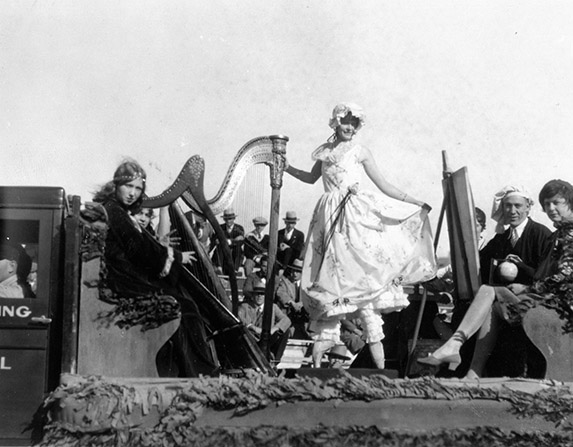
stage a parade for students, faculty, alumni
and friends on Nov. 28, 1928. Identified
simply as the "Fine Arts float," this and
the photo below are part of the WSU Alumni
Association's memorabilia collection.
The proposition was crucial; if the college were to remain an institution of higher education for area residents, rather than an elite institution for the select few, financial underwriting from the city was imperative. Fairmount alumni, according to an article in the Oct. 31, 1924 issue of the Sunflower, “heartily endorsed the Municipal University plans sponsored by Dr. Finlayson at the Alumni-Faculty entertainment held in the Morrison Library, Saturday night, October 25th.” The report continues, “The plan for a Municipal tax-supported institution has been put forth by Dr. Finlayson and L.W. Brooks, the principal of Wichita High School. The move was started at the beginning of last year. The purpose of converting Fairmount College into a University is to provide a superior institution. Finlayson laid the plan before the alumni and received their approval and backing.”
Before her death in 2013, Kathleen Walsh ’28/39, who received the Fairmount Founders Award in 1999, shared some of her memories about the campaign. Walsh came to Fairmount College in 1924 as one of the fall semester’s 460 enrolled students and quickly joined forces with fellow students who were working together with faculty, alumni and others to help convince Wichitans to support the proposition for a municipal university. Walsh recalled, “We students rolled up our sleeves, spent time at City Hall going over registration lists, and went door to door urging people to vote ‘yes.’ I worked in an area near Friends University, and more than once I got the door slammed in my face.” Put to a vote in 1925, the proposition failed. “So we just did it all over again the next year,” Walsh said. “It passed, and in the spring of 1928 I proudly graduated from the Municipal University of Wichita.”
On the occasion of being presented the 1962 Recognition Award by the WSU Alumni Association for her service as a librarian and friend to the University of Wichita and its predecessor Fairmount, Alice Isely also recalled the many efforts to establish WU, especially those of President Finlayson. “Almost from the first of his coming to Fairmount,” she said, “he envisioned a municipal university. Heroically, he worked influencing faculty to go along with him in the dream. Students and citizens gave support to the idea. When election day came, faculty members, alumni and students were everywhere serving at the polls or checking names of votes, telephoning or calling any persons who had not voted. With tenseness we waited for the result of the votes as evening came on. There were no great demonstrations when the victory was known, but there was nevertheless excitement and relief.”
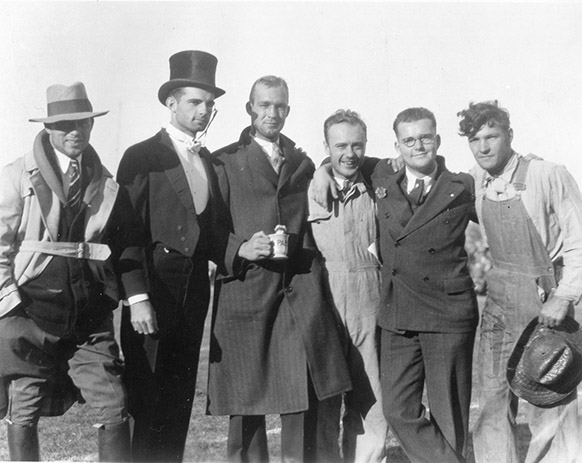
alumni and friends enjoy a campus parade
on Nov. 28, 1928. Like the photo above, this
photo also has no identification of the
parade participants, other than a penciled
in "George?"
The successful fight waged by Fairmount and its students, faculty and alumni established the ninth municipal university in the nation and the first one west of the Mississippi River. A bird’s-eye-view of WU’s campus in the mid-1920s took in only a handful of major buildings. With its stately Ionic columns, Morrison Library, built in 1908, vied with the university’s signature building Fairmount Hall as the most dominant structure. Other key buildings were Henrion Gymnasium,
the men’s dormitory Fiske Hall, completed in 1904, and the women’s counterpart of Fiske, Holyoke Cottage and Hall.
The first University of Wichita commencement took place on Tuesday, June 7, 1927 at University Chapel, where President Finlayson conferred degrees upon 52 graduates, according to the commencement program. Among the musical selections heard by
the new grads and their guests were two pieces by Thurlow Lieurance, dean of the College of Fine Arts: My Lark, My Lover and Friendship. Receiving special recognition were the six members of the Women’s Honor Group and the five members of the Men’s Honor Group, one of whom, Archie N. Booth, would begin a two-year term as president of the alumni association in 1929. In 1927, Harold Foght (1927-33) became WU’s second president.
Recalling her own 1928 graduation from the University of Wichita, Kathleen Walsh said, “Commencement was held in Henrion (gymnasium), and afterwards, we went over and broke ground for what was to become McKinley Hall, which was the real beginning of campus growth.”
But first came a fiery campus loss.
The Fairmount Hall Fire
Just days before the beginning of the 1929 fall semester, on the night of Sept. 3, a “mysterious midnight blaze destroys seat of municipal school,” as one Wichita Eagle writer reported. The article continues, “Within a few minutes after the blaze was discovered the entire bilding was in flames, and an hour later the major portion of the walls of the four-story structure had fallen in. Thousands of spectators formed a huge circle about the building as walls crumbled and fell, endangering the lives of firemen. When the south wall of the structure fell, the firemen were nearly trapped in the blazing inferno.
“Firemen saw that the building could not be saved and bent their efforts to curb the spread of the blaze. At 1 a.m., they had succeeded in preventing the Alpha Tau sorority house, which stood on the north side of the building, from catching on fire. They also spread a sheet of water about the building and on the roof of Morrison Library to prevent possible damage to it.”“A strong south wind whipped the flames and embers half a mile northward, endangering the Swallow Airplane factory and starting a prairie fire which firemen battled furiously for some time. Two hay stacks some distance from the blaze caught fire, adding to the tremendous blaze.
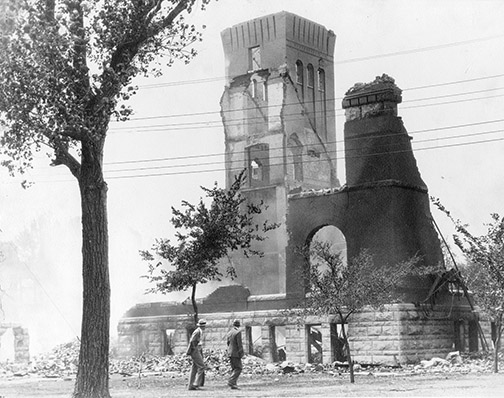
destroyed by a fire believed to have started shortly
after midnight on Sept. 4, 1929, in the structure's
basement.
The morning after the fire, President Foght announced that registration would go on as scheduled for the next Monday. He also said that a meeting of the board of regents would be called immediately to provide class rooms for the fall term. WU and Fairmount alumni did what they could to help, and just over a year later, in October 1930, the association’s The Wheatshocker publication announces: “Building Replacing Old Fairmount Hall Opened to Public.” This article, penned by Harriett Haskell, goes on to report:
With floodlights of the football field illuminating the entire campus, and with a celebration following a sumptuous banquet the new Administration building of the University of Wichita will be dedicated on the evening of October 20th.
The Henrion gymnasium will be the scene of the banquet at 6:30. Promptly at 8 o’clock a program will begin in the Auditorium annex to which all citizens of Wichita are invited. The American Legion band will play. Under the direction of Dr. Thurlow Lieurance the string ensemble will play several numbers. Following the program adjournment will be made to Administration building where Clyde M. Symser, president of the board of regents will make the dedicatory address. Inspection of the building will follow where classes will be in session.
The group will then proceed to Science hall where experiments will be carried on in the laboratories. The library will also be open to the public. Excavation for the foundation of the new building was begun Monday, January 27, 1930. … It is four stories high and measures 194 feet by 85 feet. This fire-proof structure cost $250,000 fully equipped. An impressive feature of the new building is six full length pillars at the entrance. Inside mosaic floors, marble stairs with wrought iron cases, Gothic windows, a rotunda all give the air of luxurious expanse. All administrative offices are housed in the new building.
Alumni Records, Membership “Satisfaction” and New Words for the Alma Mater
In 1930, the year the song Happy Days are Here Again ruled the top of the charts, some 2,123 students attended the municipal university, of which 765 earned degrees. On the alumni side of things, the November issue of the Wheatshocker reports that an alumni records office is being set up: “This will be a complete current file, containing name, degrees, and dates of graduation, occupation, addresses, and other information concerning the more than 1,100 graduates and many former students. This information is often valuable to you and the university — but expensive to maintain.”
The article, which focuses on alumni association expenses, goes on to report that “a central alumni office where the interests, energies, and enthusiasms of individual alumni may be pooled and used for the benefit of the university, must be financed.” The article concludes with this sentence: “The costs of Homecoming day, Alumni Commencement affairs, and other special days, must be carried by the Association.” Positioned just to the right of the “Alumni Expenses” report in the Wheatshocker is the association membership ad shown above.
In 1931, Charles “Chuck” Isely Jr. ’30, who was serving the alumni association as executive secretary, wrote this missive for the June issue of the Wheatshocker: “Next fall the new University march, ‘Hail Wichita,’ will be published in the Intercollegiate Song Book. It was written by Dean Lieurance, and has become very popular in the last two years. New words to the Old Alma Mater have been written. I feel sure that alumni will be glad to know that the old tune has been retained, even though new words are needed for the new school. For the benefit of those who have never seen them, we are reproducing them here. They were written by Doctor Mikesell, of the psychology department of the University.”
Alma Mater University of Wichita
I. Our Alma Mater Wichita
Stands proudly on the hill;
Your sons and daughters bow to thee;
Our hearts with praise we fill.
II. Around our lives are memories
That tenderly entwine;
And thru the mist of rolling years
Of thee we build a shrine.
III. Thy call to all that life holds dear
Is a clear and shining guide;
Finds love and truth and loyalty,
And may they e’er abide.
Chorus
Then Hail our Alma Mater!
Hail The, Grand and True,
Long wave the yellow and the black;
O Wichita, here’s to you.
—W.H. Mikesell
As a WU freshman in 1931, Esther Myers took up studies in English language and literature, and journalism. She graduated in 1934 with bachelor’s degrees in both. She married, became a teacher and then used her journalism training to write about her experiences as a participant in a University of Michigan graduate program in politics during a trip to Nazi Germany, where she saw Hitler during the 1936 Munich Olympics. Here is how Esther (Myers) Wenzel described the atmosphere of Oetz, Austria: “They would put on their folk dances for us. And they were very, very friendly. But, of course, from time to time, groups of German soldiers marched through the town. And that made a hush on everything.” Wenzel’s fellow WU graduate Harold Manning ’33, who set a world record in the 3,000m steeplechase at the U.S. Olympic Finals, ran in the 1936 games but didn’t medal. He treated Wenzel to a superficial tour of the Olympic village — superficial because women weren’t allowed inside.
Back in the States, Wenzel stayed connected to her alma mater and later, during World War II and the tenure of WU President William Jardine (1934-49), was hired as the first-ever paid alumni association executive secretary. The association’s newsletter dated May 5, 1945, announces: “Dear Alumni: The University has answered our request for an executive secretary by appointing Esther Myers Wenzel ’34 to that office. We have a new Alumni office at 117 Administration Building, and our phone is 4-5331. … The duty of this new office is two-way — ‘campus to alumni, and alumni to campus.’”
Wenzel’s office — half a room on the first floor of the building later named in honor of President Jardine — held a desk, a telephone and a typewriter. One of her first duties was to send out a survey to former students in the service, asking if they planned to return to college after the war ended. The May 5 newsletter reports, “Our most important job is to keep in touch with all the Alumni who are fighting on every battle front. There are 532 in our Service File. We intend to keep our service men and women posted on all the University activities, and we intend to see that you here at home become and remain interested in the problems of the University in these crucial days. Ours is the job of revitalizing 1,100 local Alumni.”
Wenzel worked for two years as the association’s executive secretary, and then Mildred “Mickey” McCoy ’45 took over. Years later, this is the way Mickey (McCoy) Armstrong described the monumental task of gathering alumni information, then organizing and maintaining it: “We worked by guess and by golly. The records from the registrar were sent over to the president’s secretary. We’d have a name and we’d try the phone book. Did someone know them? Did they work at the university? Did they go to war?” With diligence and hard work, alumni records were made. The association also sent out a monthly newsletter, and both Wenzel and Armstrong later recalled another of their association duties: selling and tracking football, baseball and theater tickets.
According to the newsletter’s Sept. 26, 1945 issue, alumni were excited that the University of Wichita had become a member of the Missouri Valley Conference and that the association had sponsored a “fine Season Ticket Sale under the chairmanship of Gifford Booth Jr. ’35, with the result of 1,056 season tickets sold. We are proud to tell you that the members of this excellent athletic committee are: Emil Holgerson ’33, our Alumni President; Dr. J.A. Bogue, Mel Binford, Harry Christopher, Lee Cornell ’26, Howard Darling ’08, Bill Piper f.s. ’38, Clarence Sutton, and Robert Shadoan ’33. We want you to keep in mind that our big Homecoming game and fall reunion will be on November 10.”
Helping Build Veterans Field
In 1946, as Perry Como’s Prisoner of Love and Frank Sinatra’s Five Minutes More topped the song charts, the WU Alumni Association was engaged in one of the most ambitious undertakings in its history: helping raise money for the construction of a football stadium. As the Feb. 9 newsletter explains:
We believe that here on the campus of the University of Wichita there should be a permanent, “living,” and useful memorial to our hundreds of men and women who served in World War II. One hundred and four of our alumni and former students gave their lives that we might live in a world of peace. An alumni memorial is our job!
Friends of the University, students, business and civic leaders, and your alumni association have endorsed Veterans’ Field, the proposed $250,000 stadium to be erected north of the Library, on the campus. Veterans’ Field will honor the 892 men and women from the University, as well as 17,857 from Sedgwick County who served in the armed forces. This new stadium will provide approximately 12,000 permanent seats, and will be completed in time for the 1946 football season. We alumni, who take special pride in the splendid services our University performed during the war years, are eager to see this memorial a reality.
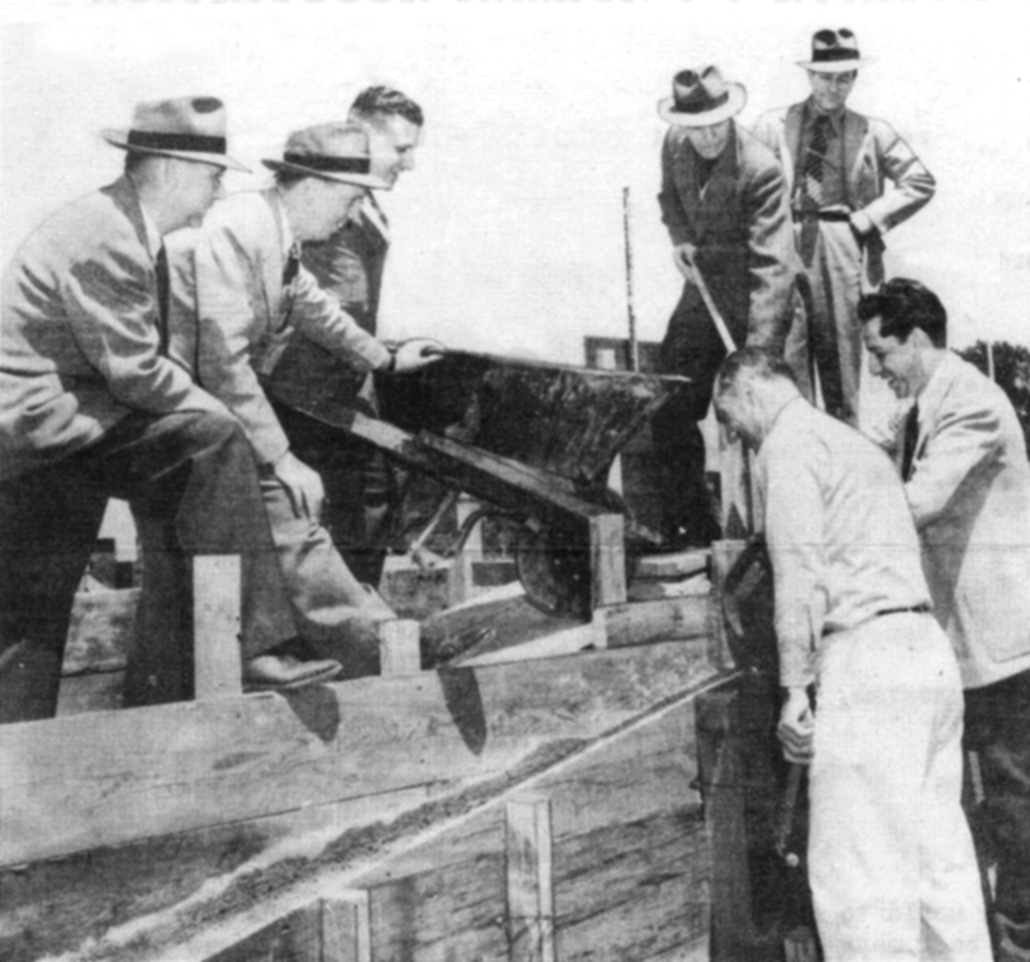
Field," the alumni association's newsletter of May
13, 1946, says: “Pictured atop the forms, from left,
are: Roy W. Elliott, University Comptroller; P.K.
Smith, Chairman of the Board of Regents; Gifford
Booth Jr. of the Executive Committee; Dr. W.M.
Jardine, University President; and Lee H. Cornell,
Chairman, Executive Committee. Standing below
are John Gaddis, Superintendent of Buildings and
Grounds; and Max Milbourn, Executive Committee."
Our University has played its part patriotically and well, and has come through the war years with distinction. One hundred and three of our men were decorated for distinguished service in every branch of the armed forces — 600 served as officers — 34 University women were in military service. In addition to these contributions by our own faculty and students, the University trained 1,760 men here in the 85th College Training Detachment of the Army Air Forces.
As you know, the Alumni Association is endeavoring to raise $60,000 as its share in building Veterans’ Field. This goal can be reached only if each one of us gives his share — $40 … Won’t you give your share today? It is our privilege to give in appreciation to the living — in memory of the dead.
A Veterans Field campaign progress report was provided in the alumni association’s newsletter of May 13, 1946: “Cement pouring for Veterans Field was viewed by officials and civic leaders Saturday, May 4, on the University of Wichita campus, as work gets under way … Extent of completion of the stadium by next fall depends largely upon the amount of donations received. $70,000 have been raised toward the $250,000 needed to complete the project. Alumni cash and pledges now total $6,187.50 with 242 contributors.”
Veterans Field, which was built in sections as funds became available, was completed for the 1948 football season, seating some 15,000 with facilities for the press, concession stands and locker rooms. On Thanksgiving Day, Nov. 25, the stands were packed, and even a WU loss to the University of Nevada did not dampen enthusiasm for the halftime program when U.S. Air Force, Army, Navy and Marine veterans unveiled the commemorative plaque and the stadium was formally dedicated “to members of the armed forces from Sedgwick County who served our nation with honor and distinction in World War II.”
W.U. Alum News, Awards and Football Ticket Sales
In 1948, Beulah O. Mullen took up the executive secretary post, a position she would serve in for 19 years. A decade after she began her alumni work, the 1958 Parnassus reports: “Graduates and former students report to Beulah Mullen when they don’t receive their copy of the Alumni Magazine. Her office compiles the monthly publication which tells the news of former students. As executive secretary of the Alumni Association, Miss Mullen also aids in the planning of the Homecoming plans for alums and the Spring Reunion.”
In the July 1949 issue of the alumni association’s newsletter, Mullen introduced alumni to the new president of the University of Wichita — Harry F. Corbin ’40 (1949-63). “We are proud to congratulate him and to wish for him many happy and successful years as the President of our University,” she wrote. After relating some biographical information about President Corbin, Mullen concluded the newsletter with this: “Word comes from Dr. and Mrs. Jardine that they are enjoying their stay at McCall, Idaho. Dr. Jardine is playing golf daily and doing some fishing. They plan to return to Wichita in time for the first football game, September 24. A letter from Athletic Director Jim Trimble is enclosed. We are pleased with the season football ticket sales of 2,288 seats to date. This should be a good beginning for our best football season yet!”
In November 1950, the alumni association brought out its Vol. 1, No. 1 issue of a bimonthly newspaper named W.U. Alum News, edited by Mullen. Front-page news items include “Southern California Chapter Has Meeting” and “1950 Football Ticket Sale Reaches New High of 3,112.” Also featured is an article about the ongoing Alumni Fund drive, which “passed the $2,600 mark this week. The class of 1939 headed by Katherine Israel Jackson contributed the highest per cent of its assigned quota with 54 per cent raised.”
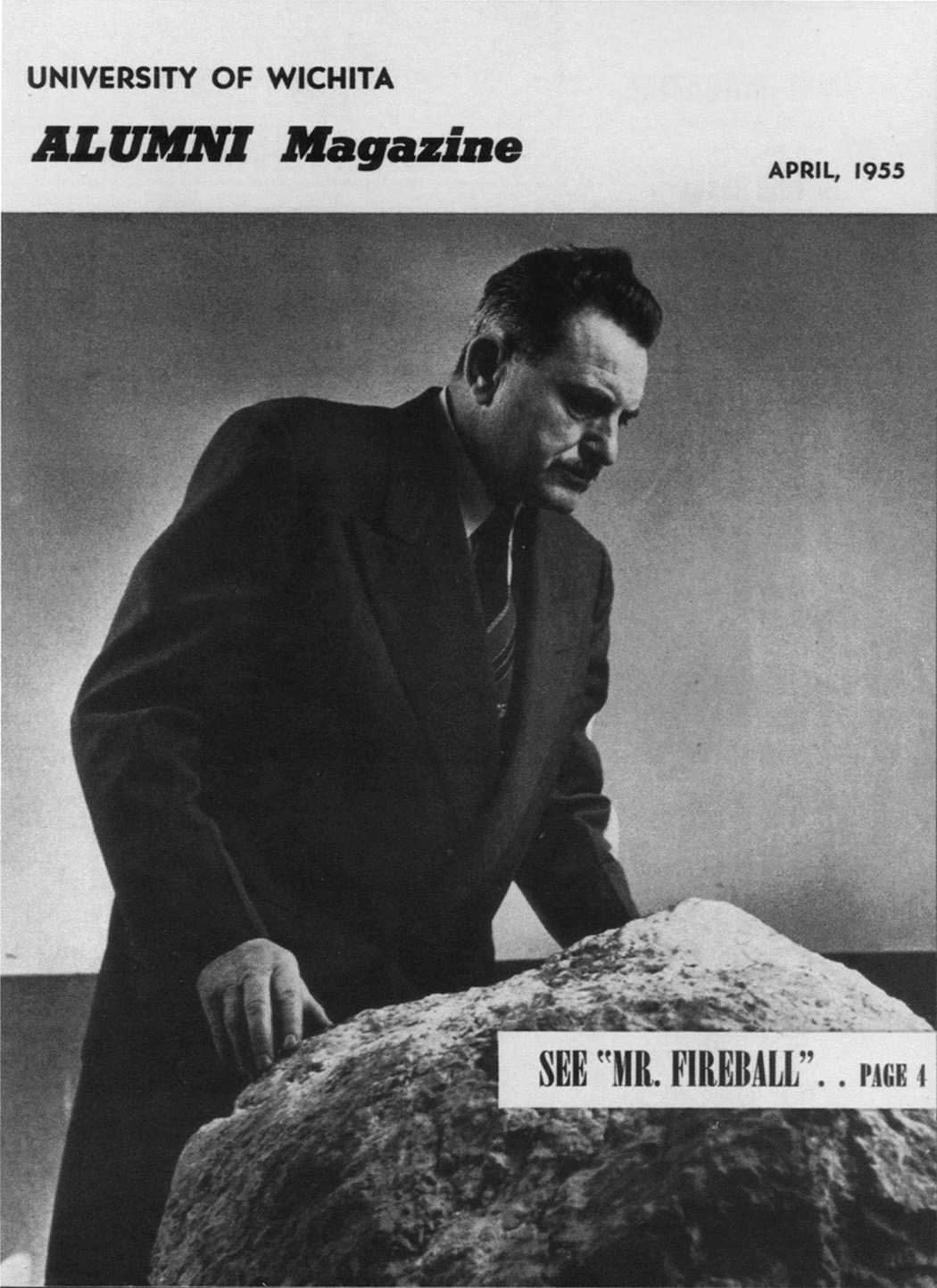
"Mr. Fireball" on the cover of
the alumni magazine shown
here, is the first person to be
recognized with the Alumni
Achievement Award, which is
the highest honor given to
alumni by the association.
Among the fund drive goals are “to establish a job placement bureau and to provide 15 scholarships here at the University.” Bentley Barnabas, chairman, organized more than 200 alumni working as class teams under the leadership of 24 class captains. The drive opened August 10 with “personal solicitation of the 2,500 alumni in the city by the captains and their agents. The drive has been extended to out-of-Wichita alumni and fund officials have been pleased with the response to the plea for alumni support in building ‘A Greater University of Wichita.’”
The 1950-51 Alumni Fund campaign resulted in 20 scholarships, according to an article in the July 1951 issue of W.U. Alum News. The paper also announces the June 2 election of Dr. D. Cramer Reed as president, as graduates and former students met in Henrion Gymnasium for the association’s annual spring dinner and reunion. “The 1951 reunion was one of the largest in University of Wichita history,” reports the alumni paper. “Over 560 alumni and wives or husbands returned to the campus for a picnic-style chicken dinner, program and business meeting. Alumni from as far away as Los Angeles and High Point, N.C., were present for the 52nd gathering of graduates and former students of the University and its predecessor, Fairmount College.”
The year 1955 was a banner year for Bill Haley & the Comets and their top-of-the-charts song Rock Around the Clock. It was also a banner year for the association. The Alumni Awards program with its annual banquet and awards ceremony was inaugurated, joining Homecoming and Spring Reunion as a signature association event. The awards program, which was established with the presentation of the Alumni Achievement Award to Lincoln LaPaz ’20, an astronomer and pioneer in the study of meteors, has grown to include the recognition of honorees of Alumni Recognition and University Recognition Awards, the Laura Cross Distinguished Service Award, the Young Alumni Award and the Award of Distinction.
From WU to Wichita State
The year 1955 also marked the beginning of hard-fought efforts for the University of Wichita to join the state system of higher education. Attempts in 1957 and 1959 failed, but the fight continued. Many alumni played key roles in assisting President Corbin in winning the political war to establish WU as a state university. Among the alumni warriors were Kathlien Edmiston ’33 and Carnot Brennan ’17.
In an open letter published in the April 1963 Alumni Magazine, Brennan, then a member of the WU Board of Regents, wrote, “On May 14, many of you will have the opportunity to vote on the proposition of whether or not Wichita University should be taken into the state system as Wichita State University. A vote in favor of this proposition will help ensure a greatly enhanced educational opportunity for the young people of the area.” The proposition was approved, Corbin stepped down as president, and Emory Lindquist (1963-68) became the first president of Wichita State. That first year, 9,300 students enrolled at WSU, compared to WU’s closing enrollment of 6,000.
In 1964, when the top song was the Beatles’ I Want to Hold Your Hand, the association was incorporated as a nonprofit organization “to promote the welfare of WSU as an educational agency and to encourage and stimulate interest of students, former students, and all others in order to promote more effectively the progress of the university.”
On campus, yet another fiery accident sparked change: Morrison Hall was destroyed by fire. Kathlien Edmiston, a political science graduate and past association president, is credited with saving three of the building’s columns from demolition. Members of the association then took the initiative in having the columns relocated to the campus’ 17th Street entrance, where nearly a decade later, in April 1973, Edmiston was on hand for the Morrison Columns dedication held during Spring Reunion. A steel box containing “important mementoes of earlier generations and current materials” was ceremonially buried under the columns by Bernard Nichols ’61, past association president, and WSU President Clark Ahlberg ’39 (1968-83), who said, “By preserving and relocating the Morrison columns to the Fairmount entrance to the campus, the alumni association has provided a visible symbol of the university’s distinguished inception and our rich heritage. We are pleased to have this symbol to remind us of our obligation to those who founded Fairmount College.”
Tragedy in Colorado
On Oct. 2, 1970, one of two planes carrying WSU football players, coaches, university administrators and boosters crashed in Colorado, claiming 31 lives. The university community and the nation reeled from the tragedy, but came together to organize a nationally televised benefit show at Henry Levitt Arena. As the Night of Stars telecast was being arranged, a second tragedy occurred: Marshall University’s team plane went down on Nov. 4; Marshall would share in the telecast proceeds.
The Nov. 28th telethon was spearheaded and emceed by Monty Hall, star and producer of the TV show Let’s Make a Deal. Bill Cosby, Mac Davis, Leif Erickson, Phil Ford, Mimi Hines, George Gobel, Humble Pie, Marilyn Maye, Minnie Pearl, the Young Americans, Lou Rawls and Kate Smith made personal appearances. A year later, Ernest Balay ’53, association president, and Ethel Jane King, hired in 1966 as the association’s first executive director, awarded Hall the first honorary membership in the association. Balay said, “He called on personal friends, giants in the entertainment business, to provide a quality show that was seen over 205 stations across the United States, a remarkable feat.” Proceeds benefited those most directly affected by the tragedies.
Nearly 40 years later, WSU alumni and friends, joined by members and former members of a Colorado Alpine Rescue Team, hiked up Mount Trelease to a forest clearing still littered with the metal debris of the plane. The visitors paid tribute to the fallen and those who survived by placing sunflowers at the site and listening to a roll call of the flight’s passengers and to President Ahlberg’s speech given on Oct. 5, 1970. Organized by alumni association staff and key alumni volunteers, including Carolyn (Howe) Harner ’67/69, the trek touched a chord of deep sadness. But hope, healing and togetherness were present as well. John Potts ’74, a freshman on the 1970 team, said, “It is important for all of us to remember that this team is not just the 1970 players themselves, but the entire faculty, staff, students, fans and alumni — then, now and forever.”
Old Traditions and A New Alumni Home
As Wichita State’s alumni body continued to grow through the years of the 1970s and ’80s and the tenure of President Warren Armstrong (1983-91), plans for a new home for the WSU Alumni Association, the WSU Endowment Association (established in 1965, today the WSU Foundation) and the Board of Trustees gained ground. Offices for these organizations were located in a variety of campus facilities prior to the completion of the Woodman Alumni Center in 1989.
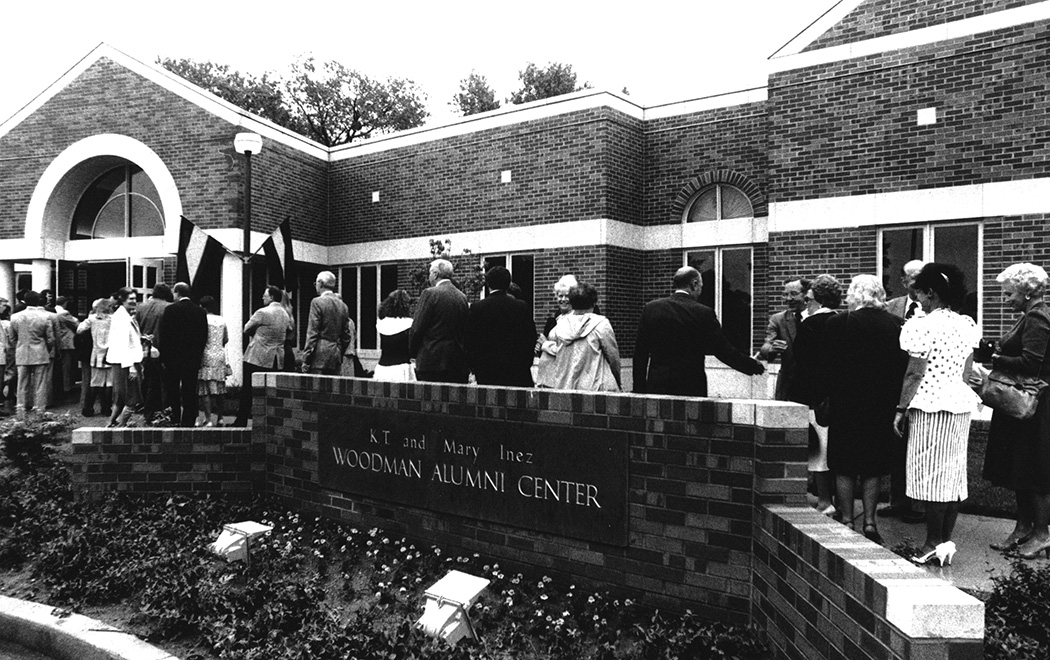
May 17, 1989. A challenge grant of $500,000 from K.T. '36 and Mary
Inez Woodman made construction of the $2.5 million building possible.
Today, the center houses three entities: the alumni association, the
WSU Foundation and the WSU Board of Trustees.
For much of her time as the second executive director of the association, Jane Gilcrist ’68 worked out of the Alumni House, an old sorority house, in the heart of campus. Gilchrist was named to the association post in 1978, the year Stayin’ Alive by the Bee Gees was the No. 1 song. Next in the association-leader queue was James Moore ’66/69, who began his work in alumni relations in 1984. Mike Meacham ’74 took up the top position in 1989, while Lynda Tousley Sade ’72 began her post in 1993. Brad Beets ’87, a former WuShock, served as executive director until 2004. Debbie Kennedy ’94, who was named executive director in 2005, became president and CEO in 2012.
Through the years, the soundtrack of the times may have changed, but association staff and volunteers have remained steadfast in strengthening alumni-to-campus and campus-to-alumni interaction through ever-widening outreach in scholarship and special project development, through ever more sophisticated ventures in recordkeeping and communication, and through an increasing number and variety of event and program offerings for constituent involvement. The Shocker Honors Scholar Banquet, an annual student recruiting event, and the Distinguished WSU Alumni Speaker Series are just two of the alumni association’s newer undertakings that have gained traditional status. And in 2010, the association brought back one old tradition that had fallen away from campus life for 20 years: Homecoming.
The full complement of university presidents, including Eugene Hughes (1993-98), Don Beggs (1999-2012) and John Bardo (inaugurated 2012); each of the 83 association presidents, starting with Harry Shuler 100 years ago; the association’s 10 administrative leaders; and every one of its volunteers — all of them have enriched the WSU Alumni Association in ways unique to their own time, talents, interests and energies. As Geraldine Hammond ’31 wrote: “Institutions do not actually exist in themselves but are only abstractions of whatever the people in them at any given moment do and are, and all the continuity or meaning institutions can ever have is in whatever is recorded and remembered of what the people in them did and were while they were there.”

